"Buy amantadine amex, xem phim antiviral".
By: W. Marius, M.B.A., M.D.
Deputy Director, Ohio University Heritage College of Osteopathic Medicine
Indirect Serologic Test 83 Part I Immunology 1/1024 1/128 1/256 1/512 1/32 Patient 1 2 3 4 5 6 7 8 1/64 Neg stages of hiv infection symptoms buy generic amantadine. Antibody Titers Most immunologic tests can be performed using direct or indirect measures stages of hiv infection cdc buy discount amantadine 100 mg online. Both will clump up to form of a lattice of antibody-bound particles in the presence of appropriate antibodies antiviral box office cheap amantadine 100mg without prescription. Natural isohemagglutinins (IgM antibodies that will agglutinate the glycoprotein molecules on the red blood cells of nonidentical individuals) are produced in response to similar molecules expressed on the intestinal normal flora hiv symptoms five years after infection purchase 100mg amantadine free shipping. A person is protected by self-tolerance from producing antibodies that would agglutinate his own red blood cells, but will produce those agglutinins that will react with the red blood cells from other individuals. These antigens can be visualized using a combination of specific antibody that is labeled or tagged with a compound used for its detection. The tissue sample to be tested is treated with antibodies against that particular antigen that have been labeled with a fluorescent dye. If the antigen is present in the tissues, the fluorescent-labeled antibodies will bind, and their binding can be detected with a microscope. Variations of this test are used to diagnose respiratory syncytial virus, herpes simplex 1 and 2, rabies in animal tissues, and Pneumocystis infections. Specific fluorescent-labeled antibody against the Ag Fluorescence in + sample Ag + Figure I-9-13. In this case, a laboratory-generated sample of infected tissue is mixed with serum from the patient. If binding of antibodies from the patient to the tissue sample occurs, then the fluorescent antibodies can be bound and detected by microscopy. This technique can be used to detect autoantibodies in various autoimmune diseases. It can be used to detect the presence of hormones, drugs, antibiotics, serum proteins, infectious disease antigens, and tumor markers. It does so by utilizing a chromogenic substrate that undergoes an enzyme-mediated color change. The serum from the patient is then added, followed by addition of an enzyme-labeled antihuman immunoglobulin. Finally, the chromogenic substrate is added, and the production of a color change in the well can be observed. This is done by sorting the cells into different populations based on their binding to specific fluorescently labelled antibodies. By using antibodies against cell-surface markers conjugated to different fluorescent dyes, it is possible to analyze the relative numbers of cells present in a specific tissue location. As cells pass through the apparatus in a single file, a computer-generated graph is produced, plotting the intensity and color of fluorescence of each cell along the axes. Each dot on the graph reflects the passage of a cell with a certain level and color of fluorescence, so the darkly dotted areas of the graph reflect the presence of many cells of similar attributes. The concept dates back into the 1100s when the Chinese practiced the art of variolation. However, the practice is credited to Edward Jenner in 1798, when he used a strain of cowpox virus to protect a child from smallpox. This chapter will discuss the science behind vaccination as well as a summary of the types of vaccine currently used in medicine. The increased speed of this response is due to the presence of the memory-cell progeny of the primary response throughout the body. The increased amplitude of effector production is due to the fact that activation and cloning begin from a much larger pool of respondents. The goal of passive immunization is transient protection or alleviation of an existing condition, whereas the goal of active immunization is the elicitation of protective immunity and immunologic memory. Active and passive immunization can be achieved by both natural and artificial means.
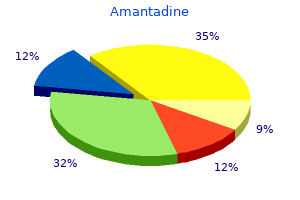
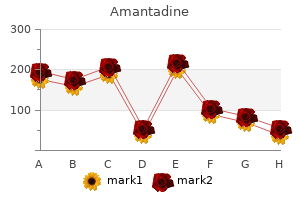
Three different responses of T cells to the presentation of peptides derived from foods and other antigens delivered via the mucosa may account for the phenomenon of oral tolerance hiv infection lung buy amantadine with a visa. The first is the deletion of antigen-specific T cells by the induction of apoptosis hiv infection rates taiwan buy amantadine with amex, which has been found to occur in experimental animals in response to oral intake of very large anti viral hand gel uk generic 100mg amantadine with mastercard, and probably nonphysiological hiv infection zero viral load buy amantadine 100 mg fast delivery, doses of antigen. This is probably not the most important mechanism of oral tolerance, although it may contribute. The second response is anergy, in which T cells presented with peptide in the absence of co-stimulatory signals become refractory to further stimulation with antigen (see Section 8-11). The development of anergy in response to a food antigen was demonstrated by feeding ovalbumin to mice that had large numbers of T cells carrying a transgenically expressed T-cell receptor for an ovalbumin peptide epitope (see Appendix I, Section A-46). Following feeding of ovalbumin, T cells bearing the transgenic T-cell receptor could still be detected, but these were totally refractory to further stimulation by ovalbumin in vitro and in vivo, even when ovalbumin was injected systemically together with an adjuvant. The third response involves the development of regulatory T cells, which can actively suppress antigen-specific responses following rechallenge with antigen. The: T cells that are abundant throughout the mucosal immune system may also have a role in oral tolerance, because tolerance appears to be reduced in mice lacking this subset of T lymphocytes. Antigen-specific suppression is a form of oral tolerance that can be transferred experimentally to recipient animals by lymphocytes derived from animals that have been fed antigen. When an animal that has been injected with such lymphocytes is exposed to the same antigen for the first time, these regulatory cells respond to the antigen and inhibit the responses of naive T cells in the recipient animal. This contrasts with anergic T cells, which cannot transfer oral tolerance following transfer to a naive animal. In order to understand the phenomenon of oral tolerance, it is essential to understand how orally delivered antigens are presented to T cells. Two routes of antigen presentation of soluble food antigens have been characterized that may induce T-cell responses favoring tolerance rather than immune activation. The first is presentation of soluble food antigens by the antigen-presenting cells of the gut and other peripheral lymphoid organs. In the absence of inflammatory stimuli, antigen presentation by dendritic cells favors the induction of tolerance rather than T-cell activation. However, this heterogeneity of cytokine responses does not fully explain tolerance to food antigens. These may be detected in the bloodstream after feeding and there is evidence that the induction of tolerance to food antigens takes place in lymph nodes and spleen as well as in the mucosal lymphoid system. We will discuss each of these mechanisms of tolerance further in Chapter 13, where we consider how the loss of tolerance to self tissues may contribute to the development of autoimmune disease. As we will see in Chapter 14, one of the strategies for treating allergy and autoimmune disease is to attempt to manipulate the nature of the antigenspecific response to stimulate T cells with the properties of such regulatory T cells. Four days later mice were injected with the relevant ovalbumin peptide with adjuvant. Eight days later the draining lymph node was harvested and the number of ovalbumin-specific transgenic T cells was measured and their proliferative response was assessed to stimulation by ovalbumin peptide in vitro. Mice fed with ovalbumin demonstrated a small reduction, compared with control-fed mice, in the number of transgenic T cells recovered, showing some deletion of T cells by orally fed antigen. However, many transgenic T cells remained in the ovalbumin-fed mice and these were refractory to stimulation by antigen in vitro, compared with the control-fed mice, which showed vigorous proliferative responses. The immune system can be divided into a series of functional anatomical compartments, of which the two most important are the peripheral lymphoid system made up of the conventionally studied spleen and lymph nodes, and the mucosal lymphoid system. Specific homing mechanisms for lymphocytes to each of these compartments serve to maintain a separate population of lymphocytes in each. The mucosal surfaces of the body are highly vulnerable to infection and possess a complex array of innate and adaptive mechanisms of immunity. The adaptive immune system of the mucosa-associated lymphoid tissues differs from that of the rest of the peripheral lymphoid system in several respects. The types and distribution of T cells differ, with significantly greater numbers of: T cells in the gut mucosa compared with peripheral lymph nodes and blood. The major antibody type secreted across the epithelial cells lining mucosal surfaces is secretory polymeric IgA. The mucosal lymphoid system is exposed to a vast array of foreign antigens from foods, from the commensal bacteria of the gut, and from pathogenic microorganisms and parasites. Indeed, soluble antigens taken by mouth may induce antigen-specific tolerance or antigen-specific suppression. It is an important challenge to understand these contrasting specific immune responses.
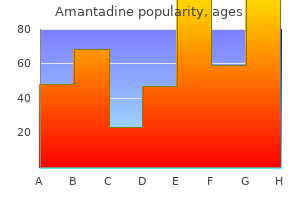
When the lesions are vesictdar or pustular hiv transmission statistics united states order cheap amantadine on line, the fluid is aspirated in capillary glass tubes or with a tuberculin syringe hiv infection statistics in kenya purchase amantadine 100mg on-line, and kept for cultural or serologic examination antiviral home remedy generic amantadine 100 mg fast delivery, q-h otc anti viral meds cheap amantadine 100 mg,: floor of the vesicles or pustules is scraped with a needle or scalpel to ol tain material {or the preparation of smears on slides. Altern,ltively, the fluid may be aspirated with a tuberculin syringe which is plac: d in a sterile rubber stoppered tube and sent to Lhelaboratory. Light-microscopy of stained, smears-Only able smears are stained, the others are reserved terial for electron microscopy or! This is wash:d off with water; equal parts of methyl violet and sodium bicarbonate are mixed, and filtered through filter paper to run under the inverted slid, supported on capillary glass tubing in a pelri dish. Staining may be accelerated by filtering the stain onto the slide and heating it gently until steam rises (stain must not be boiled). The stain is washed off the slide under tap water, dried with filte paper and mounted in liquid paraffin for examination. Virus particles, uniform in si:m, are stained brownish-bla k against a pale yellow background. Until experience has been gained with these methogs it is wise to have a omtrol preparation of vaccinia virus stained for comparison. However, it does not distinguish between variola and other poxviruses, but it does virtually rule out varicella. A negative finding in stained smears does :ot exclude a diagnosis of smallpox for much depends on the stage of the disease and the care with which the smears are made. A positive finding in smears should always be confirmed by tests for vins antigen by serologic methods and virus in culture (see below). Electron microscopy (12)-in the hands of experience(r xvorkers electron microscopy provides a reliable and rapid identification of poxvirus particles. Procedure-Smears on slides should be rubbed up with a t:i y drop of distilled water. After 5 sec excess phosphotungstate is removed with filter papel and the grid is allowed to dry. Vii"us particles nlay be seen within one minute but grids should be scanned for at least 10 rain before being considered negative. Interpretation The appearartce of smallpox and wn icella viruses as revealed by this negative staining technic is shown in Fig {i and 7. Poxvirus particles have a characteristic size and shape which is common to the variola-vaccinia group. Isolation of the virus in culture and further study are required for tJaeir separate identificatio t. In the first method, fluorescein isothiocyanate is directly conjugated with the immune serum-antivaccinial serum prepared in the rabbit, or with variola convalescent-phase serura or gamma-globulin prepared from them. The methods used in preparing gamma-globulirt, conjugation with flu:)rescent dye and absorption to remove free clye are described in Chapter 4. Figure 7 Electron micrograph o[varicelta virus from skin lesions of a chickenpox patient. Staining procedure-indirect method-After fixation in acetone, 0,1 ml of rabbit antivaccinial serum or smallpox convalescerLt serum is applied to the smear and allowed to act for 30 min at 37 C, as in the direct method. The smear is then treated with fluorescein-conjugated goat antirabbit serum or, if smallpox convalescent ser Lm has first been used, with fluorescein<onjagated rabbit antihuman serum. The slide is held in moist chamber for 10 min at 37 C and thcq washed as i I i I t above. The most suitable dilution of antiserum and conjugate to give specific staining is determined by preliminary tests with known positive s:nears. It is advisable to use for control proposes (a) a known positive smear, (b) a smear made from other skin lesions. A positive result will not distinguish a case of generalized vaccinia or cowpox from variola. Good results have been claimed for the indirect method (17, 28, 31) but it seems little superior to sLained smears of clinic :d specimens (28) and false positive results have been reported. Precipitation :es:s in agar gel have for this purpose replaced the older type of test in tubes.

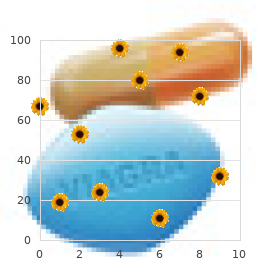
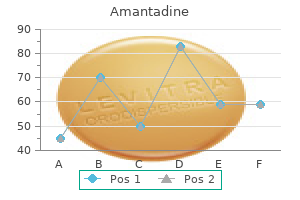
Christina Greenaway drafted the initial manuscript kleenex anti viral tissues discontinued generic amantadine 100mg without prescription, and all authors provided critical revisions and approved the final manuscript submitted for publication symptoms of hiv infection in window period generic 100mg amantadine otc. Kevin Pottie wrote the initial draft stages of hiv infection symptoms generic 100 mg amantadine mastercard, and all authors provided critical revisions and approved the final manuscript submitted for publication anti viral ear infection purchase 100mg amantadine amex. Wong, Deborah Assayag, Marc Deschenes, Chuck Hui, Erin Ueffing, Kevin Pottie, Amelia Sandoe, Meb Rashid and Jenny Heathcote contributed to the conception and refinement of the study design and the analysis and interpretation of the data. Christina Greenaway wrote the initial draft, and all authors provided critical revisions and approved the final manuscript submitted for publication. Section 10 (Intestinal parasites): Kamran Khan, Christine Heidebrecht, Jennifer Sears, Angie Chan, Meb Rashid, Christina Greenaway, William Stauffer, Lavanya Narasiah and Kevin Pottie contributed to the conception and refinement of the study design and the analysis and interpretation of the data. Kamran Khan drafted the initial manuscript, and all authors provided critical revisions and approved the final manuscript submitted for publication. McCarthy, Sunil Varghese, Ann Duggan, Glenn Campbell, Kevin Pottie and Susan Kuhn contributed to the conception and refinement of the study design and the analysis and interpretation of the data. McCarthy drafted the initial manuscript and all authors provided critical feedback and approved the final manuscript submitted for publication. Ryder, Giovani Burgos, Phyllis Zelkowitz, Kevin Pottie and Stan Kutcher contributed to conception and refinement of the study design and the analysis and interpretation of the data. Kirmayer drafted the initial manuscript and all authors provided critical feedback and approved the final manuscript submitted for publication. Kirmayer, John Feightner, Erin Ueffing and Kevin Pottie contributed to the conception and refinement of the study design and the analysis and interpretation of the data. Ghayda Hassan drafted the initial manuscript and all authors provided critical revisions and approved the final manuscript submitted for publication. Ghayda Hassan drafted the initial manuscript, and all authors provided critical revisions and approved the final manuscript submitted for publication. Section 16 (Diabetes mellitus): Arunmozhi Dominic, Kevin Pottie, Dominique Elien Massenat, Elizabeth Harvey, Jianwei Zhong and Stewart B. Harris contributed to the conception and refinement of the study design and the analysis and interpretation of the data. Arunmozhi Dominic drafted the initial manuscript, and all authors provided critical revisions and approved the final manuscript submitted for publication. Section 17 (Iron-deficiency anemia): Kevin Pottie, Andrea Chambers, Beverly Brockest, Vivian Welch and Stanley Zlotkin contributed to the conception and refinement of the study design and the analysis and interpretation of the data. Kevin Pottie drafted the initial manuscript and all authors provided critical revisions and approved the final manuscript submitted for publication. Section 18 (Dental disease): Mary McNally, Debora Matthews, Kevin Pottie, Barry Maze, Shafik Dharamsi, Helena Swinkels, Khairun Jivani, Vivian Welch and Ahsan Ullah contributed to the conception and refinement of the study design and the analysis and interpretation of the data. Mary McNally drafted the initial manuscript, and all authors provided critical revisions and approved the final manuscript submitted for publication. Section 19 (Vision health): Ralf Buhrmann, Andrew Toren, William Hodge, Allison Eyre, Michelle Martin, Walter Delpero, Robert Laroche and Kevin Pottie contributed to the conception and refinement of the study design and the analysis and interpretation of the data. Ralf Buhrmann and Andrew Toren drafted the initial manuscript and all authors provided critical revisions and approved the final manuscript submitted for publication. Section 20 (Contraception): Sheila Dunn, Praseedha Janakiram, Jennifer Blake, Susan Hum, Marianne Cheetham, Vivian Welch and Kevin Pottie contributed to the conception and refinement of the study design and the analysis and interpretation of the data. Sheila Dunn led the evidence review and all authors provided critical revisions and approved the final manuscript submitted for publication. Section 21 (Cervical cancer): Kevin Pottie, Amy Nolen, Patricia Topp, Sara Torres, Vivian Welch and Nancy Durand contributed to the conception and refinement of the study design and the analysis and interpretation of the data. Amy Nolen and Kevin Pottie drafted the initial manuscript and provided critical revisions and approved the final manuscript for publication.
Purchase amantadine 100mg with mastercard. LIFE Before Death HIV/AIDS Pain.


